Two heavyweights. One mandate: tame your cloud costs without slowing delivery. I put Cloudaware and CloudHealth through real FinOps workflows — AWS/Azure/GCP in the mix, on-prem in tow — to see who actually makes your numbers move.
Here’s what I stress-tested: daily spend breakdowns your engineers will trust, blended vs. unblended views your finance team will sign off on, hybrid cost allocation that maps cleanly to products/BUs, and tight CMDB + asset-lifecycle context so tagging isn’t a guessing game.
Bonus: the pricing math that won’t ambush your CFO. Spoiler — both shine, but in different lanes. Let’s find your fit.
Get to know Cloudaware and CloudHealth
Before we tweak forecasts, tighten tagging, or hunt another stray EBS volume, decide where FinOps will live.
Two platforms show up in most mature multi-cloud shops: Cloudaware and CloudHealth .
If you’re running hundreds or thousands of AWS, Azure, and GCP accounts, parsing CUR/ACM/GCP exports, and justifying Kubernetes spend to finance — this is the decision that sets your cadence.
The hard part isn’t a feature checklist. It’s fit:
- Does it align with your operating model (chargeback/showback, BU/Product lines)?
- Can it join your CMDB and asset lifecycle data without duct tape?
- How fast does data land, and how well does it map to tags and scopes?
- Will it plug into Jira/Slack/CI where changes actually happen?
- Is the pricing predictable at your scale?
Pick wrong and you get pretty dashboards no one uses, tags slipping, and commit planning off by a quarter.
So first, a quick overview — what each platform does, who relies on it, and where it’s strongest. Then we’ll compare daily spend breakdowns, blended vs. unblended views, hybrid allocation, CMDB integration, and pricing to help you choose with confidence.
What is Cloudaware
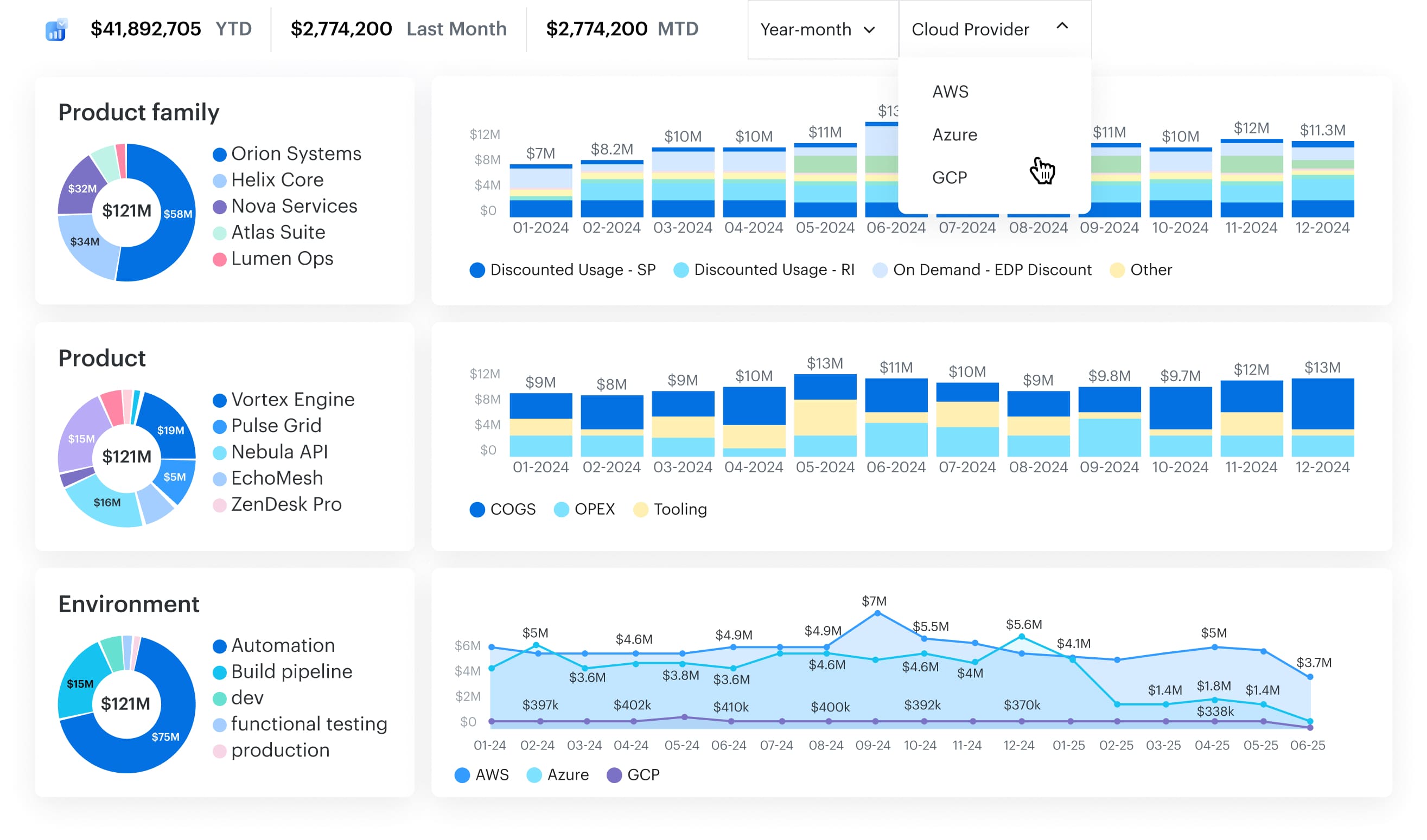
Cloudaware is for teams that need visibility with a backbone. It’s Salesforce-native, so automation, structure, and accountability are baked in.
Agentless setup: plug in read-only APIs and pull near-real-time data from AWS, Azure, GCP, Oracle Cloud, and Alibaba Cloud. Cloud costs land mapped to apps, services, regions, and environments — alongside security, infra, and CMDB context — so you always know who owns what and why it costs money.
Who uses it: FinOps managers, DevOps/Platform leads, cloud architects, and finance.
Why they stay: one source of truth, clean allocation by BU/product, blended vs. unblended views, RI/SP planning, waste/anomaly detection, plus full ITAM — cost by asset class, lifecycle, even SLA compliance.
Workflows run on Force.com logic: budget breaches open Jira tickets, idle resources get flagged in your CMDB view, alerts land in Slack, and fixes happen inside delivery.
Cloudaware is a structured cost management at scale, without agents, guesswork, or dashboard fatigue.
What is CloudHealth
CloudHealth by VMware is for teams that want proven multi-cloud cost governance. It’s VMware Tanzu CloudHealth , used by enterprise FinOps, Platform/CloudOps, finance — and a lot of MSPs.

Image source.
Agentless setup: connect read-only APIs to AWS, Azure, GCP, Oracle Cloud, and Alibaba. Add data center/vSphere if you need on-prem.
What it pulls and how it maps: cost/usage and resource metadata organized with Perspectives (tags, metadata, even CH-generated tags) and FlexOrgs for clean BU/product segmentation.
Why teams stay:
- Allocation you can defend, plus interactive reports your stakeholders can actually use.
- RI/SP and Azure Reservation planning; rightsizing across key AWS services.
- Budgets/policies and OCI governance when you expand beyond AWS/Azure/GCP.
As well as Cloudaware this platform gives you a centralized cost control and accountability across clouds, with policy-driven savings and MSP-friendly multi-tenant management.
Let’s compare them side by side:
| FinOps Capability | Cloudaware | CloudHealth |
|---|---|---|
| Supported Cloud Providers | AWS, Azure, GCP, VMware, Alibaba, Oracle Cloud, Kubernetes, Snowflake, MongoDB Atlas | AWS, Azure, GCP, Oracle Cloud (OCI), VMware/vSphere; Kubernetes cost allocation. |
| Agentless Architecture | Yes (via API integrations) | Yes (SaaS; connects via read-only roles and APIs). |
| Billing Data Ingestion | AWS CUR, Azure EA, GCP billing exports | AWS CUR (incl. CUR enablement), Azure billing via Service Principal, GCP Billing export (BigQuery/bucket). |
| Real-Time Data Processing | Real-time via cloud API polling | CUR/exports ingested on daily cycles; policies can run hourly; CloudWatch metrics can poll hourly; vSphere sync is daily. |
| Anomaly Detection | Custom thresholds + Force.com alerts/workflows | Built-in cost Anomaly Detection for unusual spend/activity. |
| Forecasting & Budgeting | Dynamic forecasting, budget thresholds, escalation workflows | ML forecasting (up to 36 months) + budgets and policy alerts. |
| Tagging & Allocation Support | You can tag any object within CMDB automatically and custom | Perspectives (rules on tags/metadata) + Tagging API; FlexOrgs for scoping; K8s allocation by requests/usage. |
| Idle Resource Detection | Idle/underutilized resource views (e.g. EBS, RIs, snapshots) | Reports/policies to find unattached EBS, idle VMs, aged snapshots; Asset Explorer queries for “orphaned/idle” assets. |
| Rightsizing Recommendations | Manual and rule-based rightsizing using CMDB relationships | Rightsizing for AWS (EC2/RDS), Azure (VM/SQL), and GCP (GCE); |
| Dashboards & Visualization | Analytics Studio + Usage Analytics (custom widgets, CMDB enriched) | AWS/Azure/GCP dashboards, Cost History, Pulse, FlexReports; multi-cloud reporting. |
| Custom Reporting | Force.com Report Builder, SLA-based views, Excel/PDF/Chatter exports | FlexReports + scheduled report exports (CSV/Google Drive) + APIs. |
| Chargeback & Showback | Unlimited. You can create any report if there is its cost data within CMDB | Partner features to generate customer billing statements, custom charges/discounts, and price books. |
| CMDB Integration | Native; links cost to infrastructure, ownership, SLA, ITAM lifecycle | No native CMDB; integrates via APIs/webhooks; CMDB sync commonly delivered via Professional Services (e.g., ServiceNow). |
| ITAM Reporting Support | Yes – cost tracking by asset lifecycle, depreciation, ownership, risk level | Limited — focus on cloud resources; on-prem via vSphere/Aria, not full ITAM lifecycle/depreciation. |
| Workflow Automation | Apex + Force.com logic; triggers, tickets, escalations | Policy engine + webhooks to trigger actions/notify third-party tools (e.g., Slack/Jira via webhook endpoints). |
| Integrations | 50+ integrations including Jira, ServiceNow, PagerDuty, New Relic, Snowflake, Datadog, etc. | Cloud provider APIs (AWS/Azure/GCP/OCI), vSphere/Aria, Datadog tags import, Wavefront (Aria Ops for Apps), Google Drive export. |
| Time to Value | 4–6 weeks (with CMDB/tag setup) | Initial cost views after first billing import (typically within ~24h); org rollout depends on FlexOrgs/Perspectives setup. |
| FinOps Support Model | Every client has a dedicated Technical Account Manager who provide personalized setup | Enterprise support + partner/MSP program; Professional Services and FinOps resources; |
| Best Fit For | Ops-led orgs with formal chargeback, ITAM, CMDB-driven governance | Enterprises/MSPs needing multi-tenant, policy-driven governance across AWS/Azure/GCP with OCI/vSphere and Kubernetes. |
You’ve met the platforms. You’re ready for the deep dive.
Visibility: unifying cloud cost insights across clouds
Not “we have a chart for that,” but answers you can act on: What are we spending? Who owns it? Is it delivering value?
That’s where Cloudaware and CloudHealth come in.
Cloudaware – FinOps visibility that thinks in context
Cloudaware ingests AWS CUR, Azure EA/Cost Management, and GCP billing, normalizes daily, and maps spend to real owners and services. No more “unknown computers in us-east-1” — think “DevOps-Sandbox-EKS-Cluster-Beta.”
What helps most:
- Daily spend is auto-enriched with project, team, and environment so owners are obvious.
Element of the Cloudaware FinOps dashboard. See it in action on a live demo. - Instant toggle between blended, unblended, amortized, and list rates so Finance and Eng align.
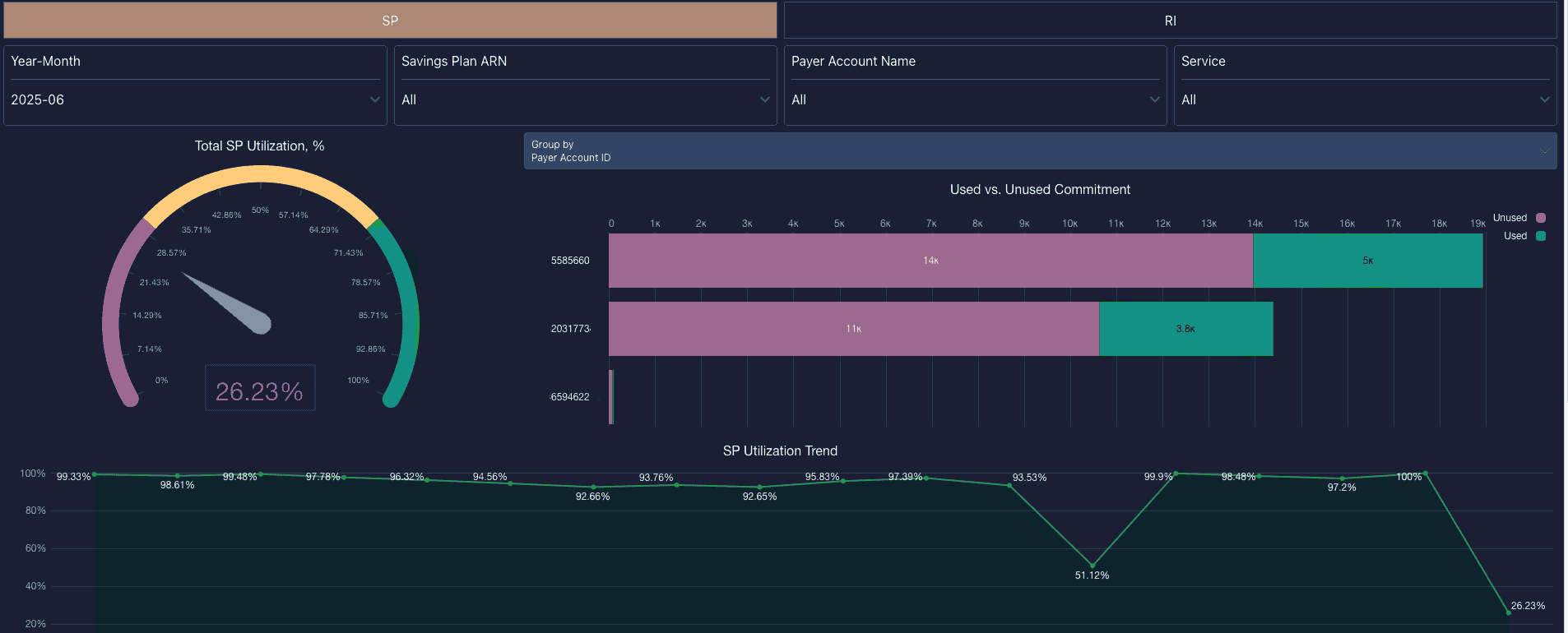
Element of the Cloudaware FinOps dashboard. See it in action on a live demo. - Missing tags surface as exceptions you can fix — not silent gaps.
- Widgets/filters are built for showback, allocation, anomaly outliers, and trends; everything is exportable and schedulable.
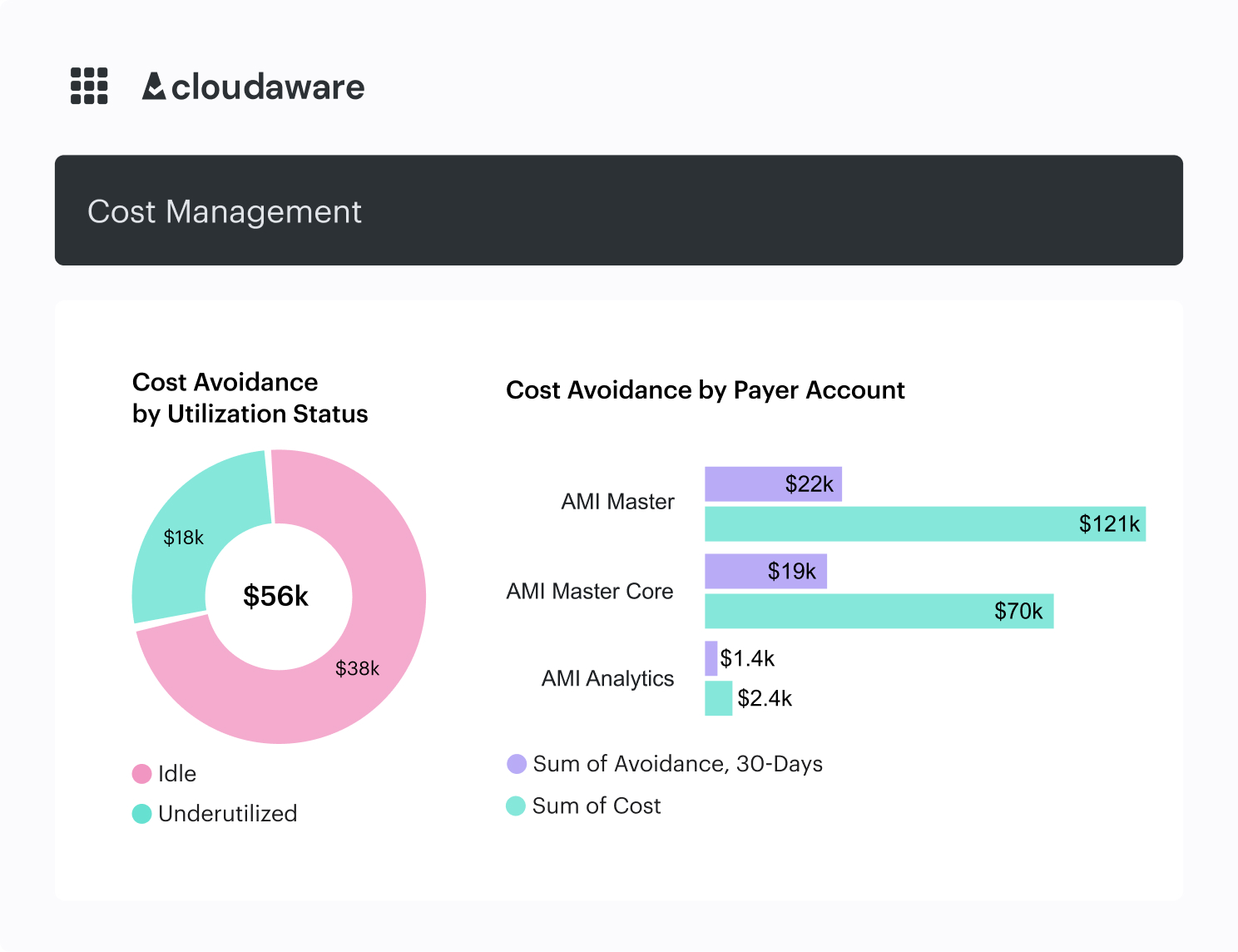
Element of the Cloudaware FinOps dashboard. See it in action on a live demo.
And it’s actionable: set alerts, rules, and workflows inside the platform to keep cost hygiene and processes aligned.
CloudHealth – visibility through business lenses
CloudHealth pivots from “cost per resource” to “cost per team, product, or feature.” It uses business context first — so imperfect tags don’t stall you.
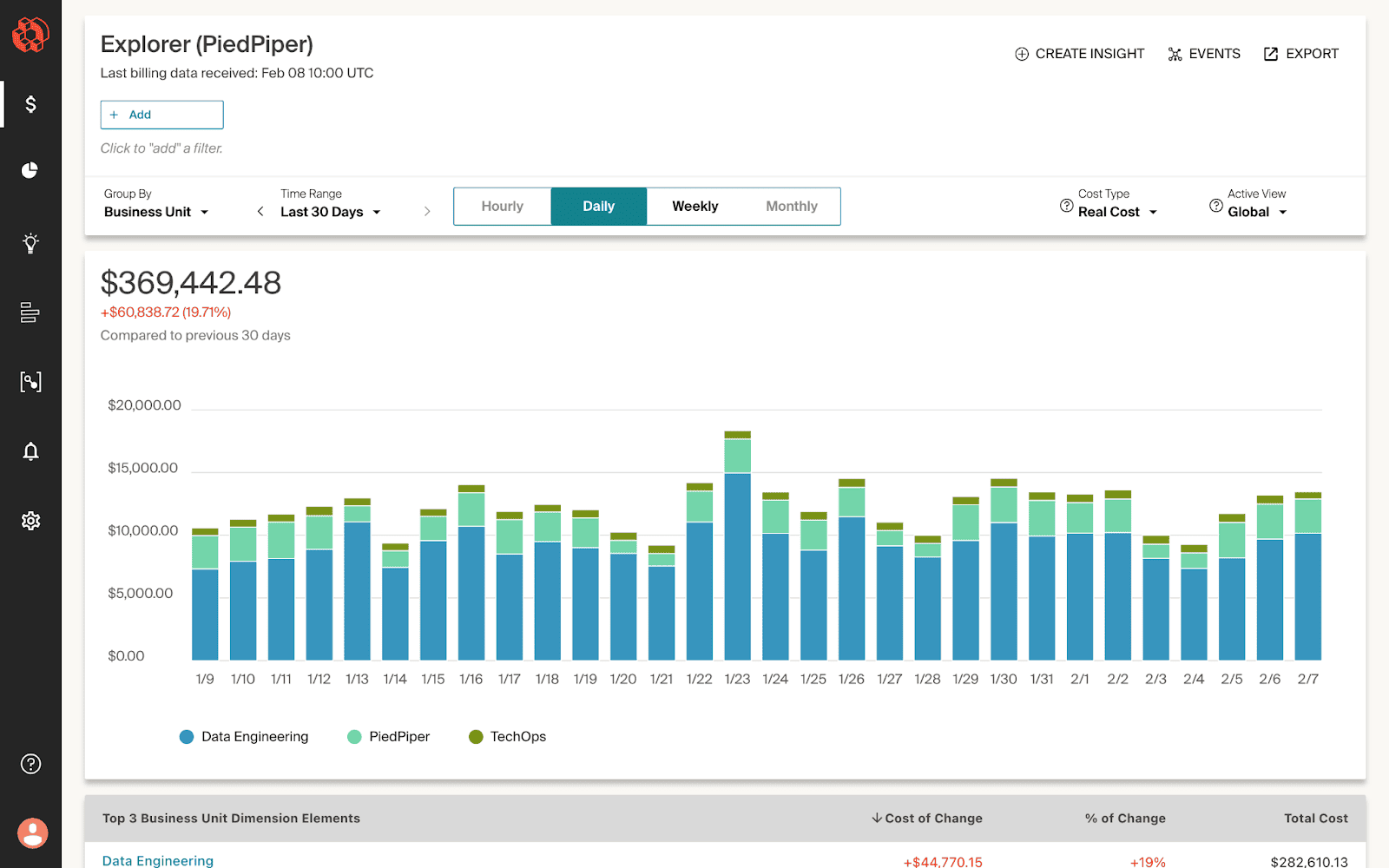
How it gets visibility right:
- Perspectives define custom views like “Feature Alpha (prod)” or “Team Bravo,” built from tags and other metadata — even untaggable assets.
- Asset Explorer/Cost History let engineers drill from spikes to the exact service, account, or cluster driving spend.
- Anomaly Detection flags unusual spend across accounts; governance policies can evaluate as often as hourly to catch issues early.
- Trend by sprint/service without a pristine tagging baseline — use Perspectives to group costs, including Kubernetes by cluster/namespace.
Net effect: costs tie back to engineering effort and product value in views your stakeholders recognize.
| Feature | Cloudaware | CloudHealth |
|---|---|---|
| Multi-cloud billing visibility | Native support for AWS CUR, Azure EA, and GCP billing | AWS, Azure, GCP billing via native connectors |
| Daily spend breakdown | Daily updated views with project/team filters | Daily cost history and Explorer drill-downs by account/service |
| Rate types supported | Blended, unblended, amortized, list — fully selectable | Blended, unblended, amortized (RI/SP) and list-rate views |
| Custom dimensions for cost grouping | Tag-based filters, custom dashboards and custom by feature, team, etc. | Perspectives (group by feature, team, customer, deploy); FlexOrgs for scopes |
| Tag hygiene handling | Flags missing/untagged resources clearly, fixes tags inconsistencies | Tagging policies and untagged cost views; exceptions surfaced for cleanup |
| Anomaly detection | Real-time via spend reports or dashboard rules | Built-in Anomaly Detection with policy alerts (hourly evaluation) |
| Engineer-friendly views | More reporting-oriented and customizable | Asset Explorer & Cost History with deep drill-downs (service/account/region) |
| Workflow automation | Built-in via Force.com (alerts, thresholds, reports) | Policy engine + webhooks/integrations (e.g., Slack/Jira) |
- With Cloudaware, you’re in control: native AWS/Azure/GCP billing, daily spend with project/team filters, one-click rate toggles (blended/unblended/amortized/list), clear tag-gap flags, and Force.com automation on top.
- With CloudHealth , you’re looking through business lenses: Perspectives to group by feature/team/customer, daily Cost History and Explorer drill-downs, anomaly detection with policy alerts, and policy/webhook workflows even when tagging isn’t perfect.
Same visibility problem, different angles. If finance asks “why did storage double?” or engineering says “not our Lambda,” start here. Visibility is the first FinOps win — and both platforms get you there.
Read also: Augmented FinOps: How the Best Teams Scale with Automation
Allocation & tagging
This is where every euro on your cloud bill should map to a team, product, cost center, or feature. On paper? Easy. In reality? Messy.
Tags drift, collide, or go missing. One service uses the Owner, another Team, and someone tagged Stage=Sandbox as production. And there’s always that EC2 box humming for months under a test account — untagged.
Meanwhile finance wants BU showback, platform needs to split shared services, and 20% of your dashboards are blank because Environment wasn’t set.
Cloudaware and CloudHealth tackle that chaos — just from different angles.
Cloudaware
As one of the best CloudHealth alternatives Cloudaware doesn’t just ingest tags — it validates them, pivots them, reconciles them with org data, and spotlights gaps. Think of it as a FinOps operations scalpel.
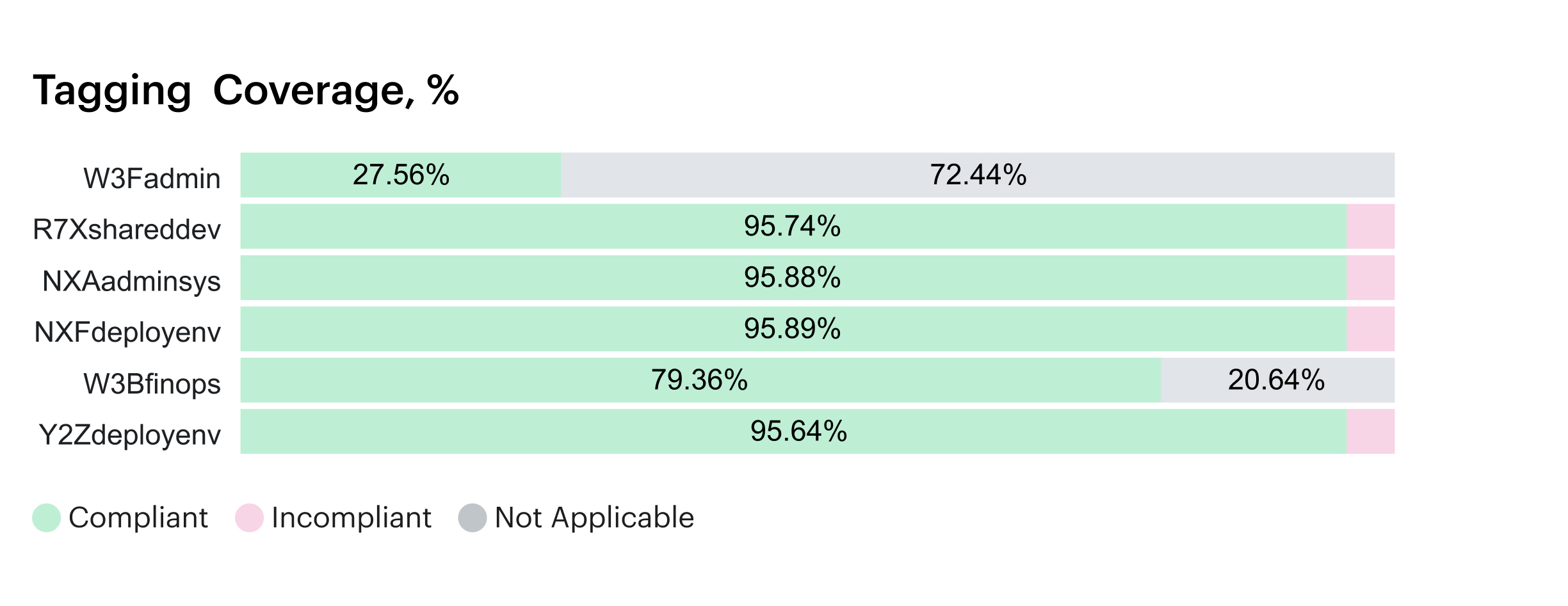
Element of the Cloudaware tagging dashboard. See it in action on a live demo.
Here’s what makes it powerful:
- Daily cost ingest from AWS CUR, Azure EA, and GCP at line-item depth.
- Tag completeness tracking to surface missing, malformed, or stale keys across thousands of rows.
- Allocation rules engine to distribute spend by tag, account, service, project, or any custom field in Salesforce/Cloudaware CMDB.
- Multi-dimensional views (e.g.,
Environment:Prod+Team:Data+Application:Kafka-Ingest) that just resolve. - Fallback logic for untagged so orphaned costs route to default owners or flagged cost centers for cleanup.

Element of the Cloudaware FinOps dashboard. See it in action on a live demo.
End state: every dollar gets a tag, an owner, and an audit trail — even if tagging wasn’t perfect on day one.
CloudHealth ’s approach?
Turn raw spend into business views your teams recognize. With Perspectives, you group costs by product, team, customer, or environment — using tags and metadata — so allocation mirrors how you run the business.
Handle the messy middle fast: add Custom Line Items (credits/debits) and use the Cost Reallocation API to spread shared charges — think NAT, support, or platform fees — across the right groups for clean showback/chargeback.
Run Kubernetes fairly: allocate container spend by requests, actual usage, or a blend; roll up by cluster, namespace, or workload so engineering sees their true costs.
Give finance the full picture: combine amortized cost reports with Perspectives to distribute RI/SP benefits to the owners who consumed them — no spreadsheets required.
Stay ahead of surprises: drill into spikes with Cost History/Asset Explorer, and use Anomaly Detection plus policies (evaluated as often as hourly) to flag outliers before they snowball.
Result: defensible allocation, less “unallocated,” and cost narratives tied to product value.
| Feature | Cloudaware | CloudHealth |
|---|---|---|
| Tag hygiene audit | Full visibility with error detection | Tag Management plus Policies surface missing/invalid tags and untagged assets for cleanup. |
| Allocation by custom logic | Tags, accounts, metadata | Perspectives (tags+metadata) for grouping, plus Cost Reallocation and Custom Line Items to split shared charges. |
| Dynamic fallback rules | Route untagged spend | Reallocate untagged/indirect spend to default Perspective groups via rules; tag-gap alerts with Policies. |
| Business-context mapping | With tagging, dimensions, and custom fields | Map by team/product/customer/env with Perspectives; scope access/reporting via FlexOrgs. |
| Multi-cloud cost alignment | Daily normalization | Daily Cost History and cross-cloud cost reports for AWS/Azure/GCP. |
When allocation breaks down, FinOps turns into guesswork — and trust me, nobody wants to defend that spending spike in a QBR with “we think it’s R&D... maybe.”
Both platforms step up to the plate. Cloudaware gives you the surgical tools to make tagging and allocation exact. CloudHealth gives you a narrative lens to make it meaningful — even if your tags are duct-taped together.
Cost optimization
You want to keep cloud spend efficient and accountable before it spikes. That means spotting over-provisioned compute, catching idle services early, and triggering alerts at the right moment — not days after finance raises a flag.
- Rightsizing aligns capacity to real usage (think EC2 or containers cruising at 10% for weeks).
- Idle detection surfaces what no one uses — volumes, snapshots, zombie databases.
- Alerts are your early warning when spend jumps, thresholds break, or configs drift out of compliance.
FinOps, DevOps, and cloud architects need tools that expose the issue and drive action — fast, at scale, across clouds.
Let’s see how Cloudaware and CloudHealth support that.
Cloudaware
Cloudaware acts like a no-nonsense FinOps analyst with deep visibility and enforceable rules.
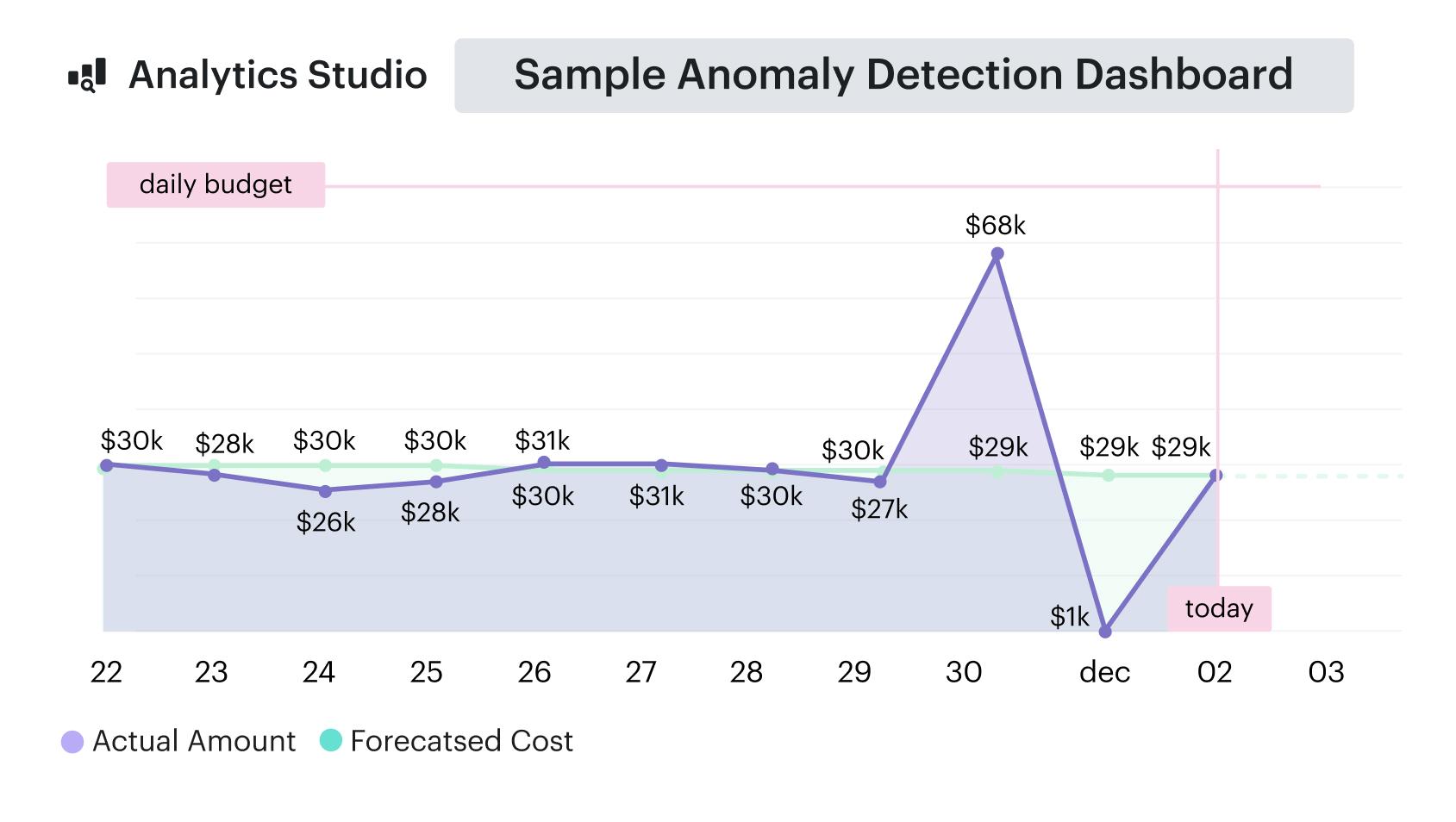
Part of the cloud forecast and anomaly detection dashboard. See it in action on a live demo.
What it actually does:
- ✅ Idle detection. Set policies like “unattached EBS > 7 days” or “EC2 < 5% CPU” → flagged, logged, routed for cleanup.
→ Teams routinely reclaim $10K+/month just by enforcing EBS rules. - ✅ Rightsizing insights. Daily views highlight over-provisioned compute across AWS, Azure, and GCP — with clear guidance on what to change.
- ✅ Custom alerting workflows. Built on Force.com: trigger on cost thresholds, tag violations, or idle policies; escalate automatically.
→ Ideal when cost guardrails tie into compliance. - ✅ Allocation + CMDB link. Every optimization item ties to a BU or service owner — no orphaned alerts.
Best if: you have defined cost guardrails, compliance requirements, and want centralized, automated FinOps workflows.
CloudHealth
CloudHealth makes idle, oversize, and anomalies visible to the teams who own them — and nudges action fast.
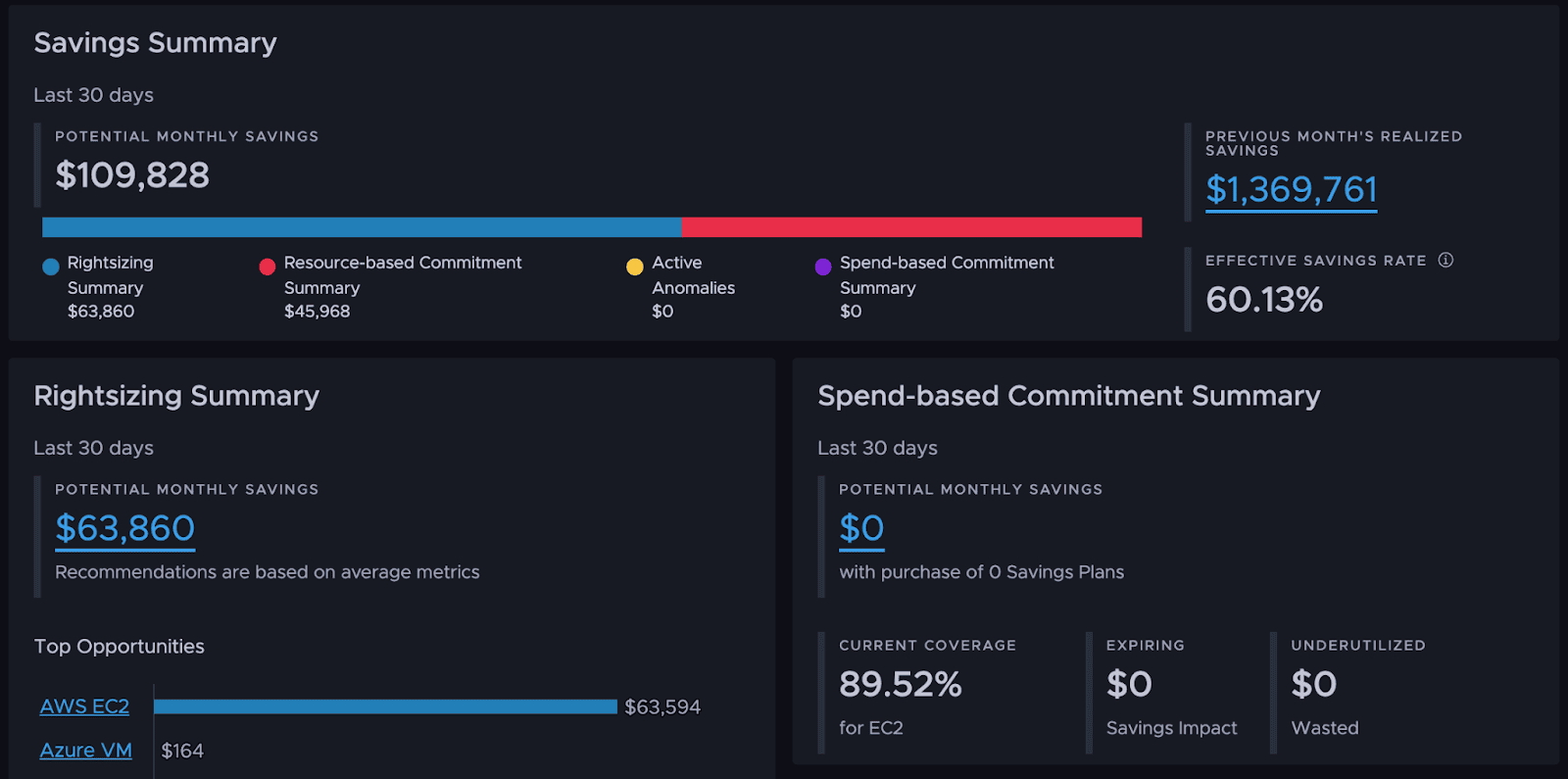
How it helps you optimize:
- Rightsizing recommendations. Identify underutilized EC2/VMs, EBS/RDS, and Kubernetes requests with actionable recs — then filter by team/product using Perspectives.
- Idle detection (works even with messy tags). Tag Management, Asset reports, and Policies surface untagged or idle resources (like unattached volumes) and route them for cleanup via rules.
- Near real-time anomaly alerts. Anomaly Detection spots unusual spend; governance policies can evaluate hourly and notify owners before costs snowball.
→ Deliver to where work happens: email, Slack, or any system via webhooks. - Embedded in team context. Scope optimization and alerts by Perspectives (team, product, environment) and FlexOrgs so each group sees — and is accountable for — its slice.
Best if: you want developer-friendly, policy-driven savings (rightsizing + anomaly response) that don’t rely on perfect tagging and align to how your org actually works.
| Task | Cloudaware | CloudHealth |
|---|---|---|
| Idle Detection | Policy-based (e.g. EBS > 7d, EC2 < 5% CPU) | Asset Explorer and Policies surface orphaned/idle resources (idle VMs, unattached disks/snapshots) for cleanup. |
| Rightsizing | Dashboard + rules-based identification | Rightsizing recommendations identify under-utilized assets; recommendations begin after sufficient telemetry (e.g., 48h). |
| Alerts & Notifications | Rule-based via Force.com | Policy-based alerts and Cost Anomaly Detection; notifications can be sent via email and webhooks. |
| Actionability | Tied to allocation rules + CMDB | Scope to owners using Perspectives/FlexOrgs, drill down to the exact resource with Asset Explorer, and trigger actions via Policies/API. |
| Workflow Integration | Salesforce-native automation | Policy engine supports webhook actions to route events into third-party tools; REST API available for integrations. |
Choose Cloudaware if you need structured control, governance-aligned alerts, and deep tagging logic that integrates with your internal cost allocation systems.
Pick CloudHealth if you want policy-driven savings tied to team “Perspectives,” fast drill-downs, and easy webhook/API hookups.
Read also: 7 Best Cost Allocation Software 2025: Tools, Features & Pricing
Forecasting & budget management
We’ve all seen it: budget locked, quarter starts fine, someone leaves a staging cluster on, and suddenly you’re over — now explaining it to finance.
What you actually need: forecasts built from real usage, live budget tracking, and alerts routed to the right owner before spend drifts — not after.
Here’s how Cloudaware and CloudHealth tackle that — same goal, different playbooks.
Cloudaware
As a CloudHealth alternative, Cloudaware is for the operations-driven brain, the type that prefers ordered dashboards, specified budgets, and rules that actually operate. It imports your cloud billing data (AWS, Azure, GCP) and overlays it with your tags, CMDB, and project ownership information.
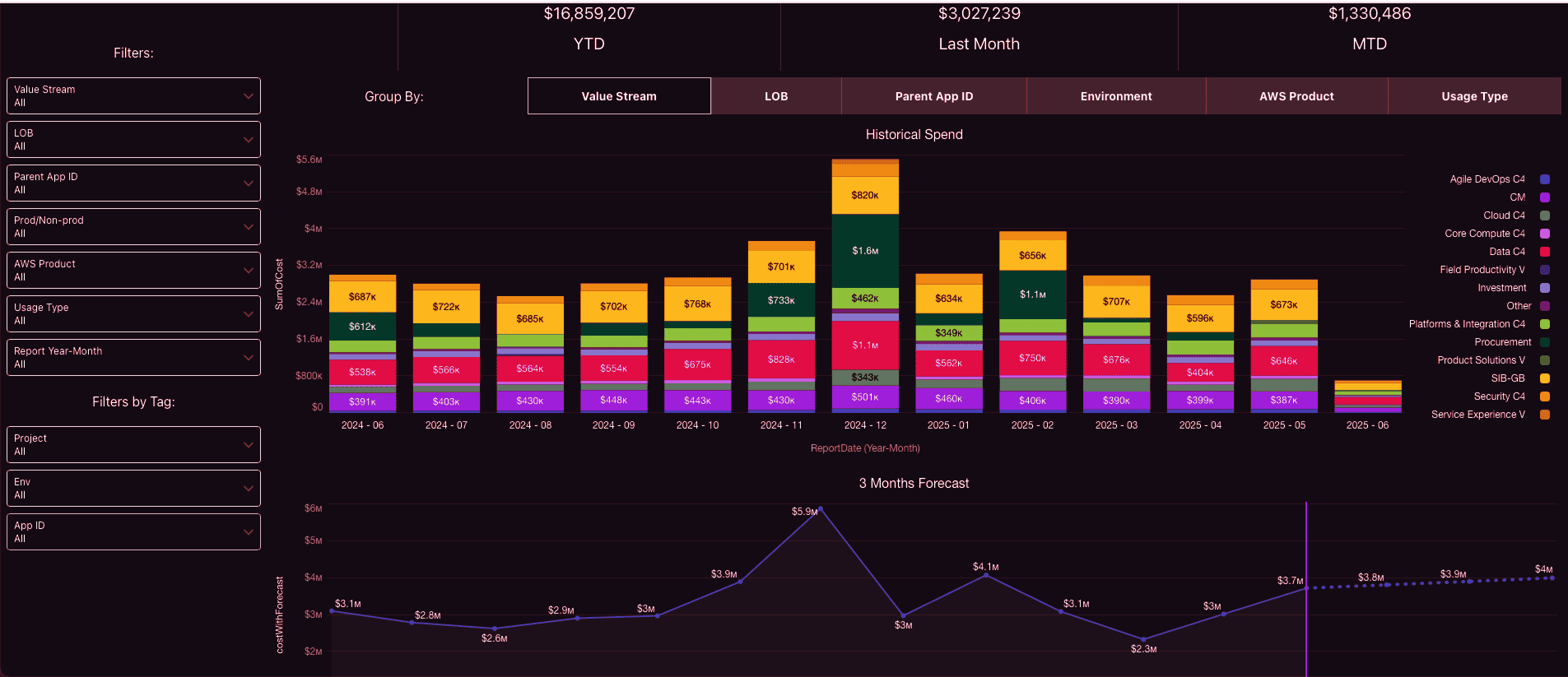
An element of the forecasting dashboard at Cloudaware. See it in action on a live demo.
Here is what it adds to the budgeting table:
- Daily auto-updated estimates for tags, accounts, services, and teams. No need for spreadsheets or guesswork.
- Threshold Alerts - Can you set a cap? Cloudaware alerts you when you're approaching it. The budget's safety net.
- Dashboards Designed for Reporting: Slice by cloud, business unit, or environment. Perfect for financial and executive decks.
- Workflow Automation - Are you going over budget? It can automatically produce a ticket, contact the app's owner, and escalate if necessary.
CloudHealth
CloudHealth FinOps lets you predict spend with ML, not guesswork. You can forecast out to 36 months, slice by Perspective (team, product, env), apply Growth Factors to model roadmap changes, and compare forecast vs. budget in one view. Save scenarios as Snapshots and turn the winning one into the budget you’ll track.
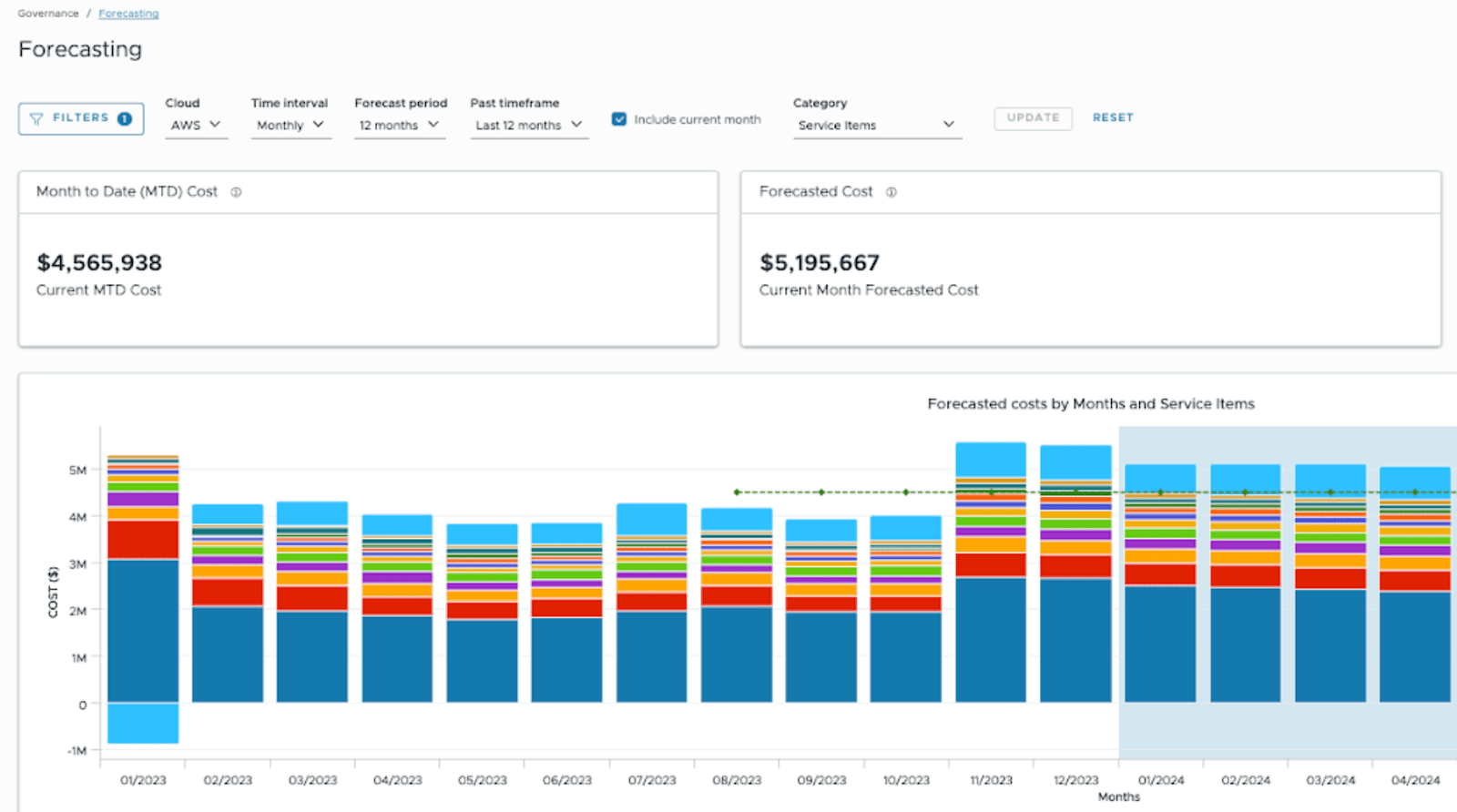
Image source.
Budgets aren’t static here — they’re operational. Create budgets per BU/product, then wire policies to alert owners when MTD actual or projected costs are trending over. Use the same lenses (Perspectives) so notifications map to how your org is structured.
Need precision on the dollars? Choose the measure you care about — Effective Cost (incl. amortized) or Cost (incl. reallocations) — and run forecasts monthly, weekly, or daily. That keeps Finance and Engineering aligned on which number is “the number.”
And when you do cross the line, the platform doesn’t whisper — it signals. Budget and cost policies can push to Slack or any system via webhooks, so the right team sees it and acts inside their workflow.
Net: forward-looking forecasts, budgets tied to business context, and alerts that reach the owner fast — so you correct mid-sprint, not at month-close.
What It Feels Like
| Feature | Cloudaware | CloudHealth |
|---|---|---|
| Budget logic | Tags + CMDB fields | Perspectives (tags + metadata) with FlexOrgs scoping |
| Forecasting | Daily trends from billing data | ML forecasting up to 36 months |
| Alerts | Triggered via internal workflows | Policies alert on MTD actual/projected over budget; notify via email/webhooks. |
| Who it helps | Finance, governance, IT leads | FinOps, Finance, CloudOps, and lines of business (budget compliance). |
| Setup vibe | Structured, rule-based | Perspective-driven, policy-based. |
What fits you?
Go Cloudaware if:
- You already track cloud costs by tag, account, or business unit.
- You want budget alerts integrated with internal approvals or ticketing.
- You’re managing formal budgets across cost centers and environments.
Go CloudHealth if:
- You need 36-month forecasts with scenarios (growth factors, snapshots) by team/product/environment.
- Your tagging is imperfect and you still want a budget vs. forecast by Perspectives/FlexOrgs.
- You want policy-driven alerts (MTD actual or projected over budget) pushed to email/Slack/webhooks.
Collaboration across teams
FinOps only works when Engineering, Finance, and Product are looking at the same numbers in the same places — and can act without a calendar invite. This section compares how Cloudaware and CloudHealth turn cost data into shared workflows: who sees what, where alerts land, and how approvals move.
What “good” looks like:
- Shared lenses: team/product/env views that match your org structure.
- Fast handoffs: alerts into Slack/Jira with owners pre-assigned.
- Guardrails: budgets, policies, and approval gates tied to change.
- Access scopes: BU-level visibility without cross-team noise.
- Traceability: every action linked to a CI, tag, or cost center.
Cloudaware leans CMDB-first with Salesforce-native automation (Apex/Force.com) to push tickets, escalations, and approvals into the delivery flow.
CloudHealth leans Perspective-first with policy/webhook workflows so each team operates inside their own slice — budgets, anomalies, and rightsizing routed to the right owners.
Now, let’s see which model fits how your teams actually ship.
Cloudaware – cost collaboration that’s buttoned up and built in
If your org is already knee-deep in Jira workflows, SLAs, and weekly reporting rituals, Cloudaware just slides right in like it was always meant to be there.
What makes it click:
- Tight integrations with Jira, PagerDuty, ServiceNow — cost alerts don’t float in space, they become action items right inside your ops tools.
- Custom dashboards with role-based access — Finance sees budgets, DevOps sees infra, SREs see what's failing.
- Force.com automation — breach a budget? Boom. Ticket’s made. Approver’s tagged. Someone’s fixing it.
- Structured insights that tie back to your CMDB, so no more “who owns this?” debates.
A friend set up workflows so that every budget anomaly got routed into Jira. No more “who’s on it?” — just resolution, fast. Unowned cost noise? Down 60%. The CFO was thrilled. The DevOps lead stopped hiding.
CloudHealth – team collaboration that moves at dev speed
CloudHealth makes Engineering, Finance, and Product look at the same numbers through business lenses, then pushes actions into the tools they already use.
- Shared views everyone trusts. Build Perspectives (team, product, environment, customer) so reports, budgets, and forecasts align to how your org is structured — no custom spreadsheets per stakeholder.
- Scoped access and accountability. Use FlexOrgs to mirror your org chart and delegate access by BU or program — each group sees its slice, admins keep global control.
- Handoffs without meetings. Governance Policies send alerts directly to owners via Slack or webhooks, so anomalies, budget breaches, and tag gaps land where work happens.
- Shareable, scheduled reporting. Stakeholders can view, export, or auto-deliver reports (PNG/CSV/Google Drive) on a schedule — reducing ad-hoc asks.
- Drill-downs for engineers, summaries for finance. Cost History/Asset Explorer let engineers trace spikes to the resource; finance gets rollups by Perspective in the same workspace.
- API-friendly for your stack. Use the REST API to feed BI, ticketing, or internal portals so teams operate from one source of truth.
CloudHealth aligns views, scopes access, and routes alerts/action items to the right team — turning cloud costs into a shared, operational workflow instead of a month-end debate.
What It feels like for real people
| Role | Cloudaware Feels Like… | CloudHealth Feels Like… |
|---|---|---|
| Finance Lead | Finally getting cost data you can trust — plus escalation flows that work | Budgets & forecasts by BU/product with Perspectives; policy alerts to owners; defendable showback |
| DevOps Engineer | Structured workflows and alerts landing in your queue | Policy/webhook alerts into Slack/Jira; Explorer drill-downs to the noisy service; quick rightsizing wins |
| Cloud Architect | Infra usage and cost linked back to actual owners | Perspectives + FlexOrgs map infra to owners; drill to assets |
| Product Manager | Visibility via reports and workflows | Feature/team views, sprint trendlines, and scheduled reports tied to roadmap decisions |
The Friend-to-Friend Decision Table
| Feature/Need | Cloudaware | CloudHealth |
|---|---|---|
| Cost alerts into workflows | Native to Jira, PagerDuty, ServiceNow | Policies send alerts via email/webhooks; route to Slack/Jira/ServiceNow |
| Role-specific dashboards | CMDB + permission-based | Perspectives + FlexOrgs; permission-scoped team/product/env views |
| Structured escalation | Force.com automations | Policy thresholds with webhook-driven escalation into ITSM/ChatOps |
| Embedded FinOps help | Dedicated FinOps Account Manager | Enterprise support + Professional Services; partner/MSP guidance |
| Setup effort | Medium (tag + CMDB power) | Medium (Perspectives/FlexOrgs setup + tag hygiene) |
- If your org thrives on structure, workflows, and defined ownership, Cloudaware is your governance soulmate.
- If your org runs on business lenses, policy alerts, and fast drill-downs, CloudHealth is your collaboration co-pilot — FinOps that fits how teams actually ship.
FinOps reporting & analytics
Reporting alone will not suffice anymore. What your organization actually needs are analytics that connect the dots between raw cloud costs and sensible business decisions on a regular basis, across teams, and without a 40-tab spreadsheet.
This task focuses on:
- Transforming cloud billing data into real-time, multidimensional insights
- Providing a clear perspective for all teams, including Finance and Engineering, and automatically identifying abnormalities, inefficiencies, and trends.
- Making sure no one is left wondering, "Where did that $40K go?"
Let's look at how Cloudaware and CloudHealth address this with features that your FinOps operations will truly rely on.
Cloudaware
Cloudaware isn’t just a reporting engine — it’s your central intelligence layer for FinOps and ITAM. With deep CMDB integration, Salesforce-native analytics, and real-time usage visibility, it gives your teams the power to turn cloud spend into action.
What you get:
✅ Analytics Studio. Dynamic, interactive dashboards that let you slice and dice usage and cost data across accounts, services, teams, regions — and tie everything back to your CMDB.
✅ Usage Analytics. Prebuilt dashboards that highlight idle resource trends, RI/SP underutilization, and high-variance workloads — customizable by cloud, service, or tagUsage Analytics - FAQ.
✅ Force.com Reporting Engine. Build complex custom reports with cost formulas, CMDB fields, tags, account metadata, and even custom SLAs. Perfect for chargeback, showback, and budget forecasting.
✅ ITAM-Specific Dashboards. Need visibility into asset lifecycle costs, license utilization, or cost-per-asset group? Use CMDB relationships to create reports for:
- Hardware/software cost by status or location
- Depreciation tracking linked to spend
- Non-compliant or orphaned asset cost mapping
- Application spend grouped by criticality or ownership
✅ Persona-Specific Views. Finance gets cost center rollups. DevOps sees infra-level inefficiencies. Asset managers get lifecycle cost analysis — all from the same system.
✅ Dashboard Concierge. Cloudaware will build complex reports and dashboards for you — yes, including ITAM views — at no additional cost.

Example of the FinOps dashboard at Cloudaware. See it in action on a live demo.
One enterprise team used Cloudaware to build a report showing all infrastructure spend tied to assets past their lifecycle renewal date. Result? They shut down $12K/month in ghost workloads in two weeks flat.
CloudHealth
CloudHealth platform turns raw billing into business-ready views you can share, schedule, and act on.

- Start with the right lens. Group costs by team, product, customer, or environment using Perspectives — rules that use tags and any asset metadata — so every report mirrors how you run the business.
- Drill when it spikes, summarize when it’s calm. Engineers trace spend to the exact service/account with Cost History and Asset Explorer, while finance sticks to rollups in the same workspace. Views run daily/weekly/monthly and default to Effective Cost when you need amortization baked in.
- Report once, share everywhere. Build a report and auto-deliver it as PNG/CSV or straight to Google Drive — no screenshots, no copy/paste. Schedule it, version it, move on.
- Let the platform tap you on the shoulder. Anomaly Detection flags unusual spend across accounts and services; policies turn those signals into alerts before the overage hits the month-end review.
- Forecasts that behave like a plan. Switch to ML forecasting to project up to 36 months, apply growth factors, compare forecast vs. budget, and keep everyone aligned on one number.
- Keep the audit trail. CloudHealth maintains lifecycle history — even when assets are modified or deleted — so TCO and compliance reviews don’t fall apart.
What teams actually get
- Business-aligned dashboards (by BU/product/feature) in minutes, not months.
- Fast root-cause on spend spikes; deep dives without leaving the report.
- Scheduled reporting that lands in stakeholders’ hands automatically.
- Forward-looking plans (36-month forecasts) tied to budgets and policy alerts.
CloudHealth gives you the shared lenses, drill-downs, and scheduled outputs to keep Engineering, Finance, and Product on the same page — so cost conversations turn into decisions, not debates.
👥 Who gets what value
| Role | Cloudaware | CloudHealth |
|---|---|---|
| Finance | Detailed, customizable cost reporting by BU, SLA, or cost center | Budgets & forecasts by BU/product (Perspectives), amortized/effective cost, scheduled report delivery |
| DevOps | Real-time usage + idle trends, rightsizing, anomaly tracking | Rightsizing + anomaly policies with alerts to Slack/email, Explorer drill-downs to service/account |
| Architect | Multi-cloud CMDB views, tag audits, infra alignment | Cross-cloud views via Perspectives/FlexOrgs, tag hygiene policies, Asset Explorer + K8s allocation |
| Product | Cost-to-feature dashboards via Studio or Concierge | Feature/team lenses, sprint trendlines, and scheduled reports tied to roadmap decisions |
Buyer’s fit guide
| Factor | Cloudaware | CloudHealth |
|---|---|---|
| Setup Time | 4–6 weeks (with tag + CMDB mapping) | Fast initial views after connectors; full value as Perspectives/FlexOrgs and policies are set up |
| Customization Power | Enterprise-grade (Force.com + Analytics Studio) | Perspective-driven grouping, FlexReports, and REST API for BI/ITSM integrations |
| Time to Insight | Moderate ramp, deeply customizable | Quick for standard dashboards; deeper slicing once business lenses are defined |
| Export Options | Excel, PDF, Chatter, Dashboard snapshots | CSV/PNG exports, scheduled email/Google Drive delivery, API access |
| Best For | Structured orgs, audit-heavy teams, SLA visibility | Product- and BU-aligned teams needing policy alerts, drill-downs |
TL;DR
- Cloudaware is your FinOps engine if you need structured, CMDB-enriched reporting, want multi-cloud analytics built for governance, and love having a support team that builds dashboards for you.
- CloudHealth is your choice if you want business-lens reporting with Perspectives, fast drill-downs to the resource, policy alerts into Slack/Jira, and multi-tenant control across AWS, Azure, and GCP.
Integrations
Having expense data from multiple sources, including AWS, Azure, GCP, Kubernetes, and Snowflake, might be overwhelming. Until someone tries to pull OpenAI usage or reconcile the Databricks invoice? Welcome to the jungle of FinOps integrations.
This task is to automate cost ingest and enrichment across IaaS, PaaS, and SaaS — without duct tape scripts or manual tagging acrobatics.
What matters most:
- Native support for cloud providers and services.
- Enhancement of business logic (CMDBs, tagging, team mapping)
- Real-time integration with ticketing, alerting, and reporting tools.
- APIs and webhooks that really operate (and do not require babysitting).
Let's talk retail – Cloudaware and CloudHealth both have their own style here.
Cloudaware
If your team lives in Jira, ServiceNow, or Salesforce, Cloudaware is your plug-and-play control tower. This platform isn’t just API-rich — it’s integration native.
Key features:
- Native billing integrations with 60+ tools like AWS, Azure, GCP, including support for linked accounts and AWS Organizations setups AWS Billing.
- Jira, ServiceNow, and PagerDuty integrations that route anomalies and budget breaches straight into workflowsOther Integrations.
- Force.com backbone lets you extend logic via Apex classes, triggers, and automated actions.
- CMDB-backed enrichment for aligning cost data with owners, environments, and SLAs
- Webhook + API support to sync into ITSM tools or external reporting systems.
CloudHealth
Here’s how CloudHealth plugs into your FinOps stack — ingest, enrich, act.
- Clouds & billing: Connect AWS (enable CUR), Azure (Service Principal), and GCP (billing export/BigQuery) for multi-cloud cost + usage in one place.
- On-prem & VMware: Add data center/vSphere accounts and even feed CloudHealth data into VMware Aria Operations via the management pack.
- Kubernetes costs: Deploy the CloudHealth Kubernetes collector (Helm) to allocate by requests, actual CPU/Memory usage — or both — so cluster spend rolls up to teams/services.
- APM/perf signals: Pull Dynatrace metrics to power EC2/Azure VM performance reports — useful for rightsizing with confidence.
- Business lenses: Use Perspectives and FlexOrgs to group costs by team/product/env and scope access per BU — no spreadsheet gymnastics.
- Policies → your tools: Policy engine fires budget/anomaly/tag alerts to email or any system via webhooks (Slack/Jira/ServiceNow endpoints).
- Reports that travel: Schedule exports as PNG/CSV or straight to Google Drive — stakeholders get the numbers automatically.
- APIs for BI/automation: Use the CloudHealth APIs to integrate with internal portals and data pipelines.
Side-by-side snapshot
| Integration Area | Cloudaware | CloudHealth |
|---|---|---|
| Cloud Billing Sources | AWS, Azure, GCP (via CUR, APIs) | AWS (CUR), Azure (Service Principal/EA), GCP (billing export) |
| ITSM Tools | Jira, ServiceNow, PagerDuty native support | Policy engine sends alerts via email/webhooks to third-party tools |
| Data Enrichment | CMDB-driven, tag-based | Perspectives with FlexOrgs for scoped views |
| Custom Logic/Rules | Apex, Force.com workflows | Policies + REST API/webhooks for automated actions and integrations |
| Best for Teams Who… | Need structured escalation + asset ownership clarity | Want business-lens reporting and policy-based alerts |
- If you’re running tight ITSM processes and care about full traceability from asset to alert, Cloudaware gives you the wiring to do it all.
- If your org runs on business lenses and fast handoffs, CloudHealth gives you Perspectives/FlexOrgs, hourly policy alerts to Slack/Jira, and Explorer deep dives — even when tagging isn’t perfect.
Read also: How Cloud Experts Use 6 FinOps Principles to Optimize Costs
Price comparison of the platforms
Cloudaware
Cloudaware doesn’t do cookie-cutter pricing. Instead, it offers a modular structure that starts with its core product — the CMDB. Because in Cloudaware’s world, there’s no FinOps without full visibility into your infrastructure. The CMDB maps every server, service, and tag in your environment, making cost analysis meaningful.
Here’s how the pricing breaks down:
- First, you buy the CMDB module, which is priced based on the number of configuration items (CIs). For most environments, this averages out to about $0.008 per CI per month.
- For a setup with 100 cloud servers, you're looking at around $400/month for CMDB.
- Then, if you want cost management features, you add the FinOps module, which is priced at 20% of your CMDB spend.
So in this case:
- CMDB: $400/month
- FinOps module: 20% of $400 = $80/month
- Total: $480/month
Compared to native tools like AWS Cost Explorer or high-cost standalone FinOps platforms, Cloudaware offers a clean, infrastructure-aware cost control platform — without the surprise bills.
CloudHealth pricing
VMware Tanzu CloudHealth doesn’t publish pricing on its site; you typically buy via sales or partners. Common CloudHealth cost model (from AWS Marketplace & industry write-ups): a flat annual fee up to a spend tier, then ~3% of monthly spend above the tier, with a $1,000/month minimum.
Examples reported:
- Up to $100K/month AWS spend ≈ $41,904/year on a 12-month term.
- Up to $150K/month AWS spend ≈ $45,000/year (12-month). 24- and 36-month terms discount the annual rate (≈12% over 36 months).
Contract terms: 12/24/36 months; longer terms → lower effective annual price.
What moves the quote: monthly cloud spend (by provider), term length, and scope (e.g., multi-cloud, Kubernetes, vSphere). Expect sales to price multi-cloud bundles even if Marketplace examples reference AWS.
So… which one’s your FinOps soulmate?
Reach for Cloudaware when…
- Context is king. You need every CUR line stitched back to an app, sprint tag, or owner without chasing teams for tag fixes.
- You’re multi-cloud (and then some). Solid on AWS/Azure/GCP, Oracle, Alibaba, plus Kubernetes allocation.
- Governance matters. Approval flows, role-based dashboards, and audit trails have to be as tight as your IAM policies.
- You still want Jira/Slack in the loop. Cloudaware fires, Slack, Email, Teams, Jira, and ServiceNow actions via Force.com flows — no extra glue code.
- Salesforce is already in your bloodstream. Reports, automations, and access controls feel native from day one.
- You’re OK investing a bit more setup time — because the payoff is iron-clad allocation and fewer “Who owns this?” moments.
Reach for CloudHealth when…
- You want business-lens views fast — build Perspectives for team/product/env without waiting on perfect tags.
- Your org is federated or multi-tenant — FlexOrgs keeps BUs, subsidiaries, or MSP customers cleanly separated.
- You run policy-first FinOps — budgets, anomalies, and tag hygiene enforced by policies (hourly if needed) with alerts to Slack/Jira/ServiceNow via webhooks.
- Engineers need instant root cause — Asset Explorer/Cost History drill from a spike to the exact account, service, or resource.
- You prefer a light initial setup — connect clouds, define a few rules, and iterate; time-to-insight is quick.
